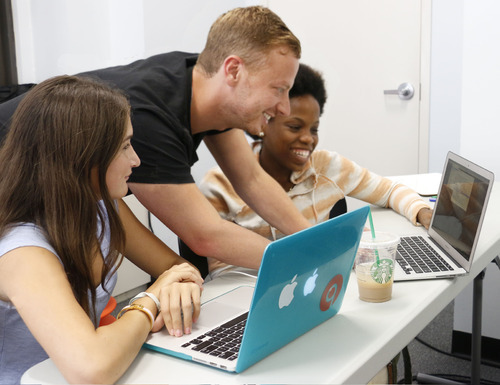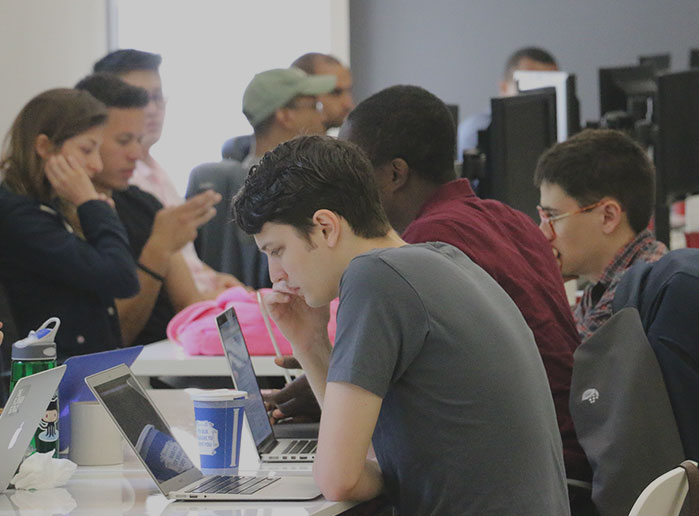Lyel Resner is a native New Yorker and the Director of K12 Education at Flatiron School. Lyel and a team of amazing teachers will be leading Flatiron After School—our brand new coding program for high school students. To kick off what is sure to be an exciting journey, he’s answered a few questions on what the program is all about.
What is Flatiron After School?
Flatiron After School is a 12-week long coding program for high school students. They’ll learn the fundamentals of web development the same way adults in our immersive programs do, regardless of how much code they know coming in. Our curriculum and differentiated teaching methods are designed to support, engage, and challenge students at all levels of experience.
Classes are held every week for a total of four hours, either after school or on the weekends. By the end of the program, students will be able to build dynamic web applications using Ruby, Sinatra, HTML, CSS and even some JavaScript. These final projects can reflect what students are actually interested in building—maybe an app that texts them the weather and outfit recommendations or one that helps them figure out what movie to watch.
You also hosted a coding program for high school students this summer—how did Flatiron Summer School influence Flatiron After School?
Flatiron After School was really built from the momentum of the summer program’s huge success. We had six groups of high schoolers who went to class every weekday for 2 weeks, and it was awesome. The program was met with an incredibly positive response from both the students and their parents—mostly because we worked super hard to gather feedback and iterate every day to make class as fun and packed with learning as possible. We learned three really, really important things this summer:
First, high schoolers can absolutely do the work. There are so few programs out there that teach them real programming material, that sometimes I feel like we totally underestimate what these students are capable of. Over the summer, we saw them take the same material we teach adults and build amazing things with it—apps that express their passions, creativity, intelligence, and incredible senses of humor through code. Why would we give them anything less difficult?
Second, teachers are absolutely everything. In a nationwide drought of computer science teachers, we are so lucky to have great ones who understand that students might not enjoy programming simply because they don’t really know what it could mean for them.
It was so cool to see our teachers, Victoria and Danny, get students (some of whom had absolutely no coding experience) really excited. And because these students were so excited, they were able to learn as much code in two weeks as the people in our adult program learn in a month.
Finally, we learned that the best classes are diverse classes. We’ve always thought that being intentional about sourcing really diverse students makes a better product and a richer experience for everyone. The summer program was a really important confirmation of this.
These students all had different interests and came from different geographic and socioeconomic backgrounds. They collaborated, broadened their experience, and (hopefully!) walked away with a few new friends. They bonded over this new learning experience and showed us that coding isn’t just for one kind of person. It’s for anyone who can get excited about it and see its possibilities.
Can you tell us a little bit about your background?
I was a physics major at MIT, so naturally, I started working on Wall Street after graduation. Ultimately, it wasn’t what I wanted from a career. I’d been volunteering as a Big Brother for more than a decade, so taking a job at an education non-profit in Harlem felt really natural.
There, I got the chance to coach a robotics team, which was a real turning point for me. Suddenly all of these really intimidating CS classes in college were no longer how I defined a technical education. I started to see technology as a platform for kids to see the best in themselves.
The rest of my career has been about helping great people build new educational programs for coding, engineering, and design for kids. I’ve helped start a non-profit called Startup Box and sometimes teach classes in social innovation at NYU Stern. Now that I’m at Flatiron School, I’m excited to keep helping kids from all kinds of different backgrounds learn about technology and build really cool things together.
Why should high school students learn how to code?
When students learn how to code they’re not just learning code. They’re learning how to learn—an essential 21st Century skill. Learning how to program means learning how to break down really big problems into tractable chunks. It means recognizing patterns, being creative and working with others to build anything you can dream up.
One of our summer students who’s just started college has already been talking to Computer Science professors about diving even deeper in the next four years. But even if the students we teach don’t want to become programmers, they can use programming as a tool to be even better at whatever it is they want to do.
When our summer students got excited about the material, they could use code to engage with things they were already passionate about on a totally different level. A girl who liked soccer built an app that sent her World Cup scores and another with an affection for animated GIFs made the whole class crack up with a GIF blog she styled. Programming gave them this whole new medium to do the things they love and share those things with others.
What are you most excited about when it comes to the high school program at Flatiron?
Honestly, the best part is how much fun everyone has. We laugh a lot. It’s so cool to see teachers and students smiling and cracking jokes, all while sharing something tremendously important. They have a great time, even when they’re teaching and learning really tough material.
Apart from that, our teachers are there to guide students—to push them and coach them way past their limit. But what they really live for is the “I can” moments that pop up the instant students get a new concept and can suddenly see a glimpse of their own possibilities. I’m so excited to see more of these moments—great teachers introducing students to even more things they’re capable of. I truly believe we’re building something special. I can’t wait.
Follow Flatiron School on Twitter for more updates on classes and workshops for high schoolers. Or learn more about Flatiron After School, including class schedules, FAQs, tuition information, and more on the program website, after.flatironschool.com.
Written byFLATIRON SCHOOL
Make yourself useful.

